Physical Therapy For People With Disabilities

A disability isn’t a bad thing. Physical therapy can often improve it. You need to be aware of the signs that can indicate if you may have a disability. These signs could include a vision problem, muscle weakness, or hearing problems.
Signs that you may have a disability
A child will typically show several developmentalally significant signs in the first two years. Mild to moderate intellectual disabilities might take longer to diagnose. This is why it is so important to keep an eye on your child’s health and wellness in tandem with your child’s academics. It also helps if you are armed with a few tips and tricks.
Don’t forget about your child’s vaccines. And don’t forget the prize! This will ensure that your children are healthy and have a bright future. You may also want to check into some specialized therapies and treatments for your child’s medical condition. A well-informed doctor is the best place to begin.
The best place to start is to be aware of what to look for to spot red flags. This is especially true if you are a parent of a child with special needs. You may want to take your child to a specialized clinic that specializes in autism, ADHD or other developmental disorders. It is also a good idea for your child to consult a pediatrician who has experience with these conditions. This is especially important when you are concerned about your child’s future health and well being.
Physical therapy can improve disabilities
Physical therapy can improve your quality life, regardless of the severity of your disability. It can prevent chronic conditions like arthritis from getting worse. It can help to reduce pain and swelling and prevent disabling injuries. Physical therapy can also improve mobility and independence.
Physical therapy can be used to improve mobility in people with a variety disability. It is also used to treat musculoskeletal disorders, cardiopulmonary diseases, neurological conditions, and pediatric conditions. By creating individualized programs for each patient, physical therapists can help you get maximum benefit from your rehabilitation. They may also recommend therapeutic devices. These devices can include strengthening exercises, electrical stimulation, and balance training.
Physical therapy was traditionally done within a medical model. This model has been replaced by the International Classification of Functioning of the World Health Organization. The ICF’s focus is on participation, activity, inclusion, and disability. This is important as the ICF aims to shift the focus from impairment towards more participation.
Physical therapy education also continues to emphasize the complexity of disability. It continues to place disability within a social and cultural context. The emphasis has shifted from pedagogical approaches to disability that emphasize disability as a problem to disability as an identity.
Physical therapy is an essential component of the healthcare system. It can help people with disabilities improve mobility, independence, quality of life, and quality. Physical therapists can also help to prevent or delay chronic diseases through the incorporation of physical activity into their treatment.
As you learn more about the health and wellness of people with disabilities, you will want to incorporate some of the principles of disability studies into your practice. Begin by introducing students and faculty to the medical and social aspects of disability. This will enable you to challenge ableist assumptions and build your curriculum.
Disabilities that do not appear
80% of disabled people in the UK have a disability that isn’t obvious. These are sometimes called hidden disabilities, because they don’t have obvious visual or physical signals to alert people to their condition. They can be chronic diseases, mental illness, extreme fatigue, or panic attacks.
There are several things you can try to improve the situation. First, learn as much as you can about your disability. You should also be open to sharing this knowledge with others. Third, be patient. Fourth, don’t judge someone based on their appearance or the use of a particular restroom.
Getting the right accommodations can make a huge difference in the lives of people with invisible disabilities. You might have missed a few days because of a chronic illness. If you don’t, your co-workers might feel that you’re getting an unfair advantage.
Hidden disabilities can also cause misperceptions and misunderstandings. Some people are uncomfortable with people with invisible disabilities, because they feel that they’re being given special treatment.
It is important to remember that every disability affects individuals differently. This means that accommodations are not always necessary for everyone with a disability. It is important to try to understand the unique needs of your employee and to find a way to accommodate them in a way that works both for you.
It is best to create a list with all your employees and then to discuss the most appropriate accommodations.
Disabilities prohibited by the ADA
The ADA (Americans with Disabilities Act), is a comprehensive civil rights legislation that prohibits discrimination based on disability. It is enforced through the Department of Justice, Equal Employment Opportunity Commission, as well as other federal agencies. It applies to all private employers, public organizations, labor organizations and joint labor-management boards.
The ADA prohibits discrimination in employment and public accommodations. It also requires employers to provide reasonable accommodations to qualified individuals with disabilities. A qualified person is someone who meets the job requirements and has a disability. This person must have a physical or mental impairment that substantially limits one or more major life activities.
The ADA has five sections. Title I, which covers qualified individuals with disabilities, protects them from discrimination in the workplace. This section applies only to private employers that have 15 or more employees. Title II, which covers qualified individuals with disabilities, protects them from discrimination in public service. This section covers state and local government entities, public agencies, public housing agencies, commuter authorities, and other private entities.
Title III, which is the third section, prohibits discrimination due to disability in public accommodations. This section covers places of public accommodation, including hotels, movie theaters, public transportation, and most recreation facilities. It also covers commercial buildings. The ADA requires all public accommodation that is newly constructed or altered to conform with the ADA Standards.
The fourth section, Title IV covers Congress, state, local governments, as well as other public entities. It requires U.S. telecom companies to make their services easily accessible. It also prohibits discrimination in educational programs.
The fifth section, Title VII prohibits discrimination based upon disability in federally-funded programs. It applies to both the state and local governments as well as public higher education institutions.
Disabilities that are being advanced by developments in technology
Individuals with disability services in Melbourne are increasingly embracing the digital world in ways that are not apparent only a few years back. Technology has made it possible to communicate with the outside, learn new skills, shop in ways that were previously unimaginable. However, these technological advances can bring new and unexpected challenges to people with disabilities. These innovations may not help people with disabilities realize their full potential. It remains to see.
Technology is a complicated beast. Understanding its underlying components is the best way for a person with disabilities to evaluate its suitability. Apart from the obvious considerations such as ergonomics and restraining device, there are other important factors to consider. If someone is interested in a career within the tech sector, they need to know that technology isn’t just about gadgets or computers. It is not surprising that individuals with disabilities will need a multi-pronged approach in their career. It is crucial that only the most important people have access to the information they need in order to be successful. This includes the information necessary to choose which technology to use in the first place. To ensure that an individual with disabilities achieves their goals, it is essential to establish policies that allow for proper technology use. This can be done in many ways. For example, providing the correct training for people with disabilities and making sure that the right people get the right technology at right times.





